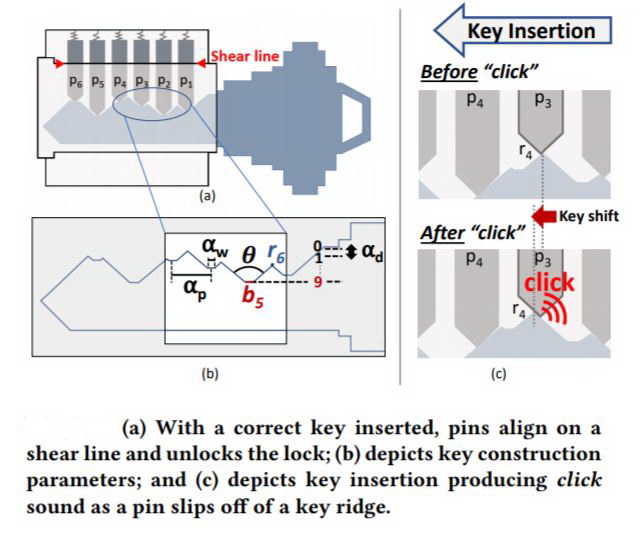Científicos de la Universidad Nacional de Singapur han publicado un informe sobre la interesante técnica SpiKey que permite abrir una cerradura. Argumentan que haber escuchado y grabado el sonido de la cerradura al abrirse, puedes recoger la llave de esta misma cerradura.
Los investigadores dicen que una cerradura física, por supuesto, se puede romper de una manera más tradicional, pero esto requerirá ciertos conocimientos, habilidades y herramientas. Además, los ladrones comunes dejan huellas en el interior de la cerradura, que luego pueden ser detectados por expertos forenses.
De hecho, El ataque propuesto por los investigadores sugiere usar el micrófono de un teléfono inteligente normal para capturar el sonido al insertar y extraer una llave de la cerradura.. Este sonido permite concluir sobre la forma de la llave y su barba., y luego creando una copia.

Así que, un software especial determina el tiempo entre clics, cuando la llave hace contacto con los pasadores de la cerradura, y, basado en estos datos, recrea la clave misma. Después, Los datos obtenidos se pueden utilizar para crear una copia de la clave., por ejemplo, usando una impresora 3D.
"Como resultado, el programa ofrece varias claves candidatas adecuadas, y ni una sola opción ya preparada. Sin embargo, Este análisis “acústico” de una llave típica de seis terminales nos permite rechazar más de 94% de las llaves y dejar sólo unos 10 claves candidatas (a menudo habrá sólo 3 claves candidatas)", – explican los investigadores.
El método SpiKey tiene una serie de debilidades. Por ejemplo, algunos tipos de llaves, cuando se inserta en el ojo de una cerradura, emitir los llamados «clics superpuestos», que son extremadamente difíciles de analizar, y por esta razon, solo sobre 56% de las claves son vulnerables a SpiKey.
Además, para obtener los mejores resultados de análisis, un software especial requiere una velocidad constante al girar la llave en la cerradura, lo que simplemente no sucede en la vida real.
Sin embargo, Este matiz se puede mitigar grabando el sonido al abrir/cerrar la cerradura varias veces.. Para hacer esto, el atacante puede instalar malware en el teléfono inteligente o reloj inteligente de la víctima (para grabar los sonidos deseados), o recopilar datos de sensores de puertas, si están equipados con micrófonos.
Los investigadores señalan que los clics deben registrarse a una distancia de aproximadamente 10 centímetros de la cerradura, y para distancias más largas es necesario un micrófono parabólico.
"No hay razón para creer que las cerraduras digitales brindarán mayor seguridad, especialmente considerando el número actual de ciberataques. Mientras que los ataques a cerraduras físicas requieren la presencia de un atacante, Los ataques digitales pueden ser remotos e intimidantes.. Quizás deberíamos inspirarnos en la autenticación de dos factores, y la combinación de cerraduras físicas y digitales es la forma más segura de lograr un desarrollo más detallado”., — concluyen los expertos.
Déjame recordarte también que El hacker “Tamagotchi” Flipper Zero llega a Kickstarter y recoge 7 veces más de lo planeado.

